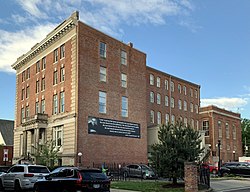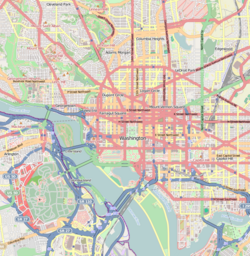Twelfth Street YMCA Building, also known as Anthony Bowen YMCA, was home to the first African American chapter of YMCA, founded in 1853 by Anthony Bowen. It is located at 1816 12th Street NW in the U Street Corridor (Cardozo/Shaw) neighborhood of Washington, D.C. The building was reopened on February 20, 2000, as the Thurgood Marshall Center in honor of the first African American Associate Justice to serve on the United States Supreme Court. The Thurgood Marshall Center now serves as a community center for residents of the U Street Corridor and Shaw neighborhoods. The permanent organization of Phi Beta Sigma fraternity was established in the Bowen Room.
Twelfth Street YMCA Building | |
 Twelfth Street YMCA Building in 2023 | |
| Location | 1816 12th St. NW, Washington, D.C. |
|---|---|
| Coordinates | 38°54′53.8″N 77°01′41.8″W / 38.914944°N 77.028278°W |
| Area | .395 acres (1,600 m2)[1] |
| Built | 1908-12 |
| Architect | William Sidney Pittman |
| Architectural style | Renaissance Revival |
| Part of | Greater U Street Historic District[2] (ID93001129) |
| NRHP reference No. | 83003523 |
| Significant dates | |
| Added to NRHP | October 3, 1983[3] |
| Designated NHL | October 12, 1994[4] |
| Designated DCIHS | April 29, 1975 |
Completed in 1912, the Renaissance Revival building was designed by William Sidney Pittman, one of the United States' first African American architects and a son-in-law of Booker T. Washington. It was declared a National Historic Landmark in 1994 and is a contributing property to the Greater U Street Historic District.[1][4]
Description and history
editThe Thurgood Marshall Center is located on the west side of 12th Street NW, between S and T Streets. It is a large rectangular four-story masonry building, built out of red brick with trim of limestone and gray brick. Its main facade is three bays wide, with a center entrance sheltered by a Tuscan portico with entablature, modillioned cornice, and low balustrade above. The ground floor is finished in bands of gray brick arranged to appear as rough stone, while the upper floors are red brick with gray brick corner quoining. Limestone stringcourses serve as a water table between the basement and first floor, between the first and second floors, and above the top floor. The building is crowned by a modillioned and dentillated cornice and a low balustrade. Windows are set in pairs in each bay, with limestone keystones.[1]
The international YMCA was founded in Great Britain in 1844, and its first American branch opened in 1851. Anthony Bowen founded the first African-American branch of the organization in 1853 in Washington, one year after a branch for whites was opened in the city. The organization struggled financially in its early years, and was not formally incorporated until 1892. The organization moved into its first permanent home on 11th Street in 1891, which soon after had to be sold due to declining membership. After a membership drive revitalized the organization, it secured a pledge from John D. Rockefeller Sr. for $25,000, which was matched by fundraising from across the nation's African-American community. It is believed to be the first such campaign of its type in that community. This building was completed in 1912 to a design by African-American architect William Sidney Pittman.[1]
In 1973 Twelfth Street YMCA was officially renamed Anthony Bowen YMCA in honor of its founder. It closed in 1982, suffering from declining membership and mounting building maintenance costs.[1] Politicians Washington DC Congressional Delegate Walter E Fauntroy and Washington D.C Mayor Marion Barry lead several protest demanding the reopening due to its historical significance.[5] In 1983, the building was nominated as Historic Landmark[6] but not until 1989 that Congressional Delegate Walter Fauntroy introduced to Congress the bill to designate the Anthony Bowen Landmark Building (formerly the Anthony Bowen Y.M.C.A.) in Washington, the District of Columbia as a national historic site,[7] declaring this historic building National Historic Landmark on October 12, 1994.[8]
The restoration of the building started with Walter Fauntroy's plan to improve opportunities for neighborhood youth in the Shaw community. In 1983, in coordination with Real Estate developer George T. Farrell, Walter Fauntroy fully restored the building and adapted it for the use of the community by providing a full service health and recreational facility administered by the YMCA. The renovation spurred increased gentrification of the Shaw community from a low income enclave to a young urban professional locale bringing a surprising change for the current residents. The Antony Bowen YMCA operated as a community recreation center with gymnasium and library until it was again renovated to become the Thurgood Marshall Community Center under direction of the Thurgood Marshal Center Trust, Incorporated.[9]
Notable people
edit- John Warren Davis, fifth president of West Virginia State College, served as the executive secretary of the Twelfth Street YMCA from 1917 to 1919.[10][11][12]
See also
editReferences
edit- ^ a b c d e Laura Harris Hughes and Laura V. Trieschmann (March 1994). "National Register of Historic Places Inventory-Nomination: Twelfth Street Young Men's Christian Association Building / Anthony Bowen Young Men's Christian Association Building" (pdf). National Park Service.
{{cite journal}}: Cite journal requires|journal=(help) and Accompanying nine photos, exterior and interior, from 1994 (32 KB) - ^ Trieschmann, Laura V.; Sellin, Anne; Callcott, Stephen (November 1998), National Register of Historic Places Registration Form: Greater U Street Historic District (PDF), retrieved March 31, 2015.
- ^ "National Register Information System". National Register of Historic Places. National Park Service. January 23, 2007.
- ^ a b "Twelfth Street YMCA Building". National Historic Landmark summary listing. National Park Service. Archived from the original on 2011-06-06. Retrieved 2008-05-12.
- ^ Perl, Peter (March 29, 1982). "Reopening of Bowen Y Demanded at Rally". Washington Post.
- ^ "NPGallery Digital Asset Management System". October 3, 1983.
- ^ US Congress, 101st Congress (1989-1990) (June 2, 1989). "H.R.2301 - To designate the Anthony Bowen Landmark Building (formerly the Anthony Bowen Y.M.C.A.) in Washington, the District of Columbia as a national historic site, and for other purposes". Congress.gov.
{{cite web}}: CS1 maint: numeric names: authors list (link) - ^ "Anthony Bowen YMCA (Twelfth Street YMCA)". DC Historic Sites.
- ^ Haq, Adil (April 29, 1999). "YMCA Renovation to Begin". Washington Post.
- ^ Smith, Gerald L. (1994). A Black Educator in the Segregated South. Lexington, Kentucky: University Press of Kentucky. p. 61. ISBN 9780813118567. OCLC 622296614 – via Internet Archive.
- ^ Goggin, Jacqueline Anne (1993). Carter G. Woodson: A Life in Black History. Baton Rouge, Louisiana: Louisiana State University Press. p. 54. ISBN 9780807117934. OCLC 45843468 – via Internet Archive.
- ^ Moorland–Spingarn Research Center Staff (1 October 2015). Davis, John Warren. Washington, D.C.: Howard University. p. 5. Archived from the original on 13 April 2020. Retrieved 13 April 2020.

